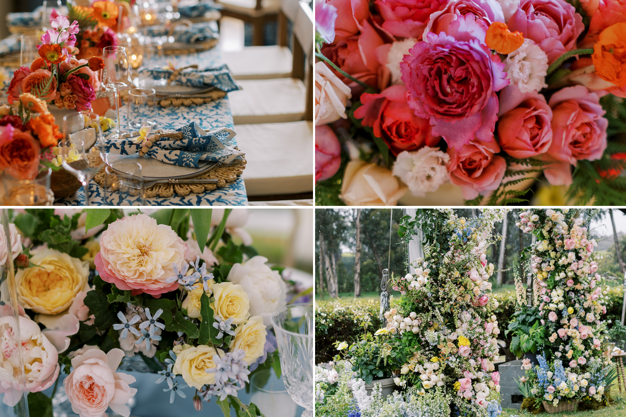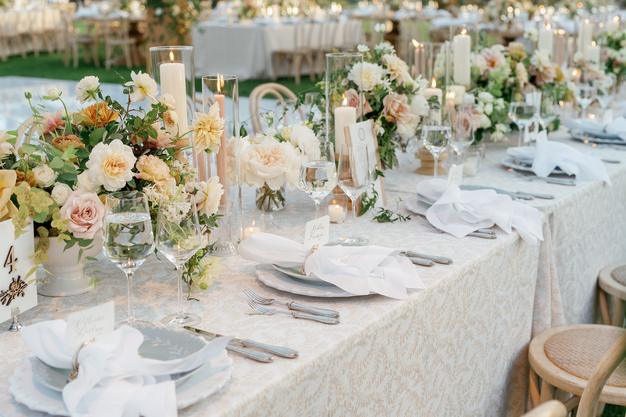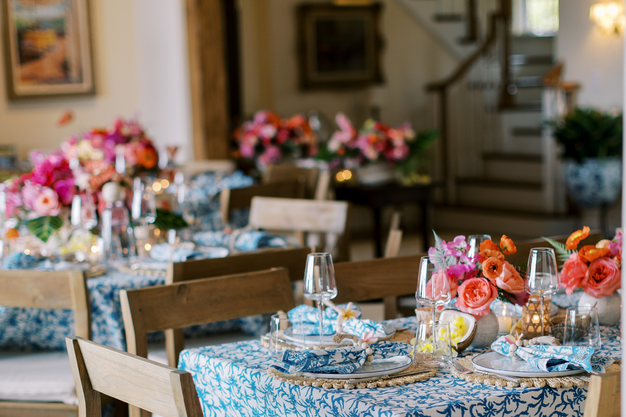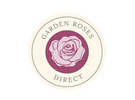"The wedding industry continues to be a dynamic space for floral professionals, where trends shift with the seasons, and the demand for innovation is ever-present," states Joost Bongaerts, CEO of Florabundance. Florabundance is a flower wholesaler in the USA which ships flowers throughout all of the United States. Their wedding season starts in the southern states in February/March, and slows down in mid-November.

Floral installation designed and created by Toast Santa Barbara
As we approach fall, the world of wedding florals is poised for developments that growers and wholesalers need to be prepared for. Therefore, we asked Joost to offer his perspective on the latest trends in the world of wedding florals. Moreover, he offers tips on how growers and wholesalers can anticipate floral trends.
Summer versus fall hues
According to Joost, one of the most significant changes this year is that couples move away from the once-dominant neutral tones and embrace more vibrant, bold colors. "Yellows, lavenders, and mixed color palettes are making their mark, bringing a refreshing energy to wedding celebrations. These colors not only align with current trends but also offer a broader canvas for creative floral designs that stand out in the market," says Joost.
 Some of the color palettes that were observed this summer, designed and created by Toast Santa Barbara
Some of the color palettes that were observed this summer, designed and created by Toast Santa Barbara
Nevertheless, he anticipates that the arrival of fall will result in a comeback of the traditional neutrals, saying: "Rich browns, terracotta's, and other earth tones are expected to dominate, providing a warm and inviting contrast to the brighter summer hues. For growers and wholesalers, this means a potential shift in demand that requires strategic planning to ensure the right varieties are available when needed."
What's in and what's out?
As always, certain flowers rise in popularity while others take a backseat, Joost observes that poppy pods, calla lilies, anthuriums, and David Austin garden roses (also known as David Austin wedding roses) are currently in high demand.
He explains why:"Poppy pods have become highly sought after, adding texture and a touch of whimsy to floral arrangements. The sleek, modern appeal of calla lilies and anthuriums has also captured the attention of designers, making them staples in contemporary wedding themes. Conversely, the move away from neutral tones has led to a decline in the use of flowers like quicksand roses, which were once wedding favorites."
Structured designs
At Florabundance, they also observe a shift towards structured floral arrangements. "Unlike the wild, free-flowing bouquets that once dominated weddings, today's couples are opting for designs that emphasize form, structure, and artistry. These arrangements often feature fewer flowers but are meticulously crafted to create a strong visual impact through their intentional composition and use of negative space. This trend underscores the importance of quality over quantity, with a focus on precision and creativity. Growers and wholesalers should be prepared to supply florists with flowers that lend themselves well to these structured designs—sturdy stems, unique textures, and striking silhouettes will be in high demand."
 Designed and created by Toast Santa Barbara
Designed and created by Toast Santa Barbara
Anticipating floral trends
Throughout this article, Joost stressed more than once that growers and wholesalers should prepare for next season's trends. He states that it is well-possible to do so by closely observing several factors such as developments in consumer preferences, trends in fashion and interior design, as well as the influence of social media, global events and cultural shifts.
"By staying attuned to this kind of indicators, professionals in the floral industry can not only see trends coming but also adapt and innovate to meet the evolving demands of their customers," Joost says.
In the remainder of this article, he will share some insights on what to look for.
Monitoring consumer behavior
First of all, growers and wholesalers can anticipate trends by monitoring shifts in consumer behavior, Joost says. "Think of a growing interest in sustainability or self-care. Florists and designers can anticipate changes in floral preferences. For example, the increasing popularity of bright colors or structural arrangements in weddings reflects broader aesthetic trends."
For this reason, he is in favor of industry collaboration and networking. "Florists, growers, and wholesalers often share insights at industry events, trade shows, and through professional networks. This collaboration can lead to early identification of emerging trends."
He also points out that the availability of seasonal flowers can drive trends. "Peonies, ranunculus, or alliums may become particularly popular during their peak seasons, influencing design choices for weddings and events. Similarly, the economy can influence trends as well. For instance, during economic downturns, there may be a shift toward more cost-effective flowers and simpler arrangements."
Other dynamics
Yet, he highlights that it's not only the flower industry that sets the tone for the upcoming wedding seasons. The dynamics of fashion, interior design, social media, global events, and cultural shift also come into play.
Joost: "Trends in fashion, interior design, and even broader cultural movements often influence floral trends. Florists keep an eye on runway shows, home decor magazines, and design blogs to identify emerging color palettes, textures, and styles that may cross over into floral design.
Moreover, platforms like Instagram, Pinterest, and TikTok play a significant role in shaping trends. Floral designers often monitor these platforms to see what types of arrangements, colors, and flowers are being featured by influencers and in viral content.
We also shouldn't underestimate the impact of events such as royal weddings, celebrity weddings, or significant cultural celebrations. They can set trends that ripple through the industry. A high-profile event featuring a specific flower or color scheme can lead to a surge in demand for those elements."

Designed and created by Toast Santa Barbara
A busy season ahead
At Florabundance, they are already busy with preparing for the next wedding season. "Many inquiries arrive weeks and months in advance. We are starting to prepare for the next season, focusing on trends, seasonal availability, and what our clients might be looking for. It's important to stay ahead, especially as we transition into fall and winter, when the demand for certain flowers changes and colors shifts.
We're also keeping an eye on what's popular 'cool stuff' as some of our team members and buyers refer. And we stay in touch with flower breeders and growers about new varieties that might be coming into the market. Preparing for the next season is all about ensuring we have the right selection and quality to meet our customers' needs."
As fall approaches, the wedding season is expected to ramp up, with larger and more elaborate floral arrangements taking center stage. "For floral professionals, this means a busy and dynamic period, where flexibility and readiness to meet last-minute demands will be crucial.
With new trends emerging the opportunities for growers and wholesalers to innovate and adapt are plentiful. Growers and wholesalers can innovate by offering unique and trending flower varieties, enhancing customization and flexibility in orders, utilizing advanced logistics for faster delivery, and adopting digital tools for better customer engagement and service," Joost concludes.
For more information:
Florabundance
Joost Bongaerts
[email protected]
www.florabundance.com
Garden Roses Direct
www.gardenrosesdirect.com
Photo credits
- Fall neutral tones are @chardphoto Rich Lander
- Vibrant/spring/tropical tones are @danielle_honea Danielle Honea
All floral designs are created by Toast Santa Barbara










